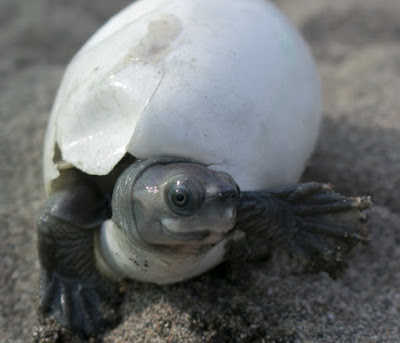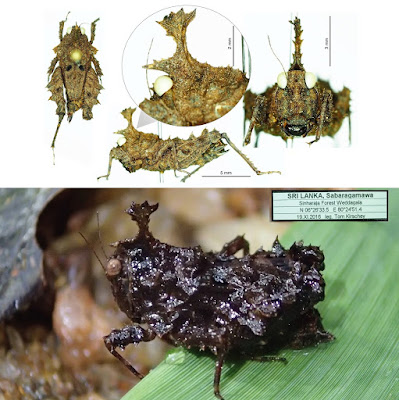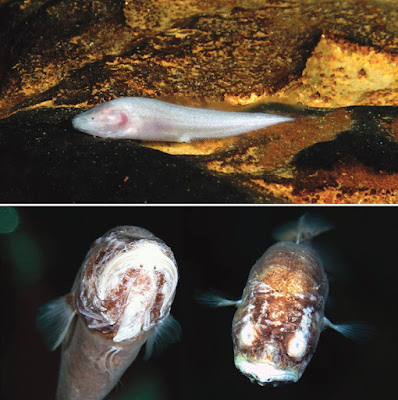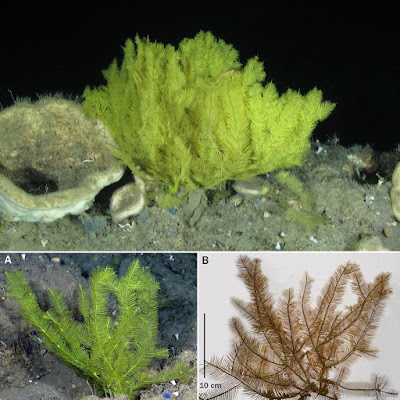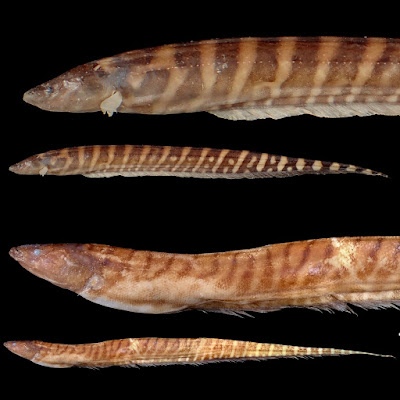[Most Recent Entries] [Calendar View]
Monday, August 3rd, 2020
| Time | Event | ||||||||
| 3:46a | [Herpetology • 2020] First Description of Neonate Batagur trivittata (Testudines: Geoemydidae)
The Burmese Roofed Turtle (Batagur trivittata Duméril & Bibron, 1835) is a large (straight-line carapace length [CL] to 620 mm; Platt et al., 2019), aquatic, herbivorous turtle endemic to the major river systems of Myanmar (Smith 1931; TTWG 2017). Although historically widespread and apparently abundant, long-term population declines resulted from chronic egg collecting, subsistence harvesting of adults, and loss of critical nesting habitat (Platt et al. 2017a). By the late 1990s B. trivittata was considered a candidate for Extinct status (Bhupathy et al. 2000) until a living specimen purchased in a Chinese wildlife market came into the possession of an American turtle collector in the early 2000s (Platt et al. 2005; W.P. McCord, pers. comm.). Shortly thereafter, field surveys “rediscovered” two remnant populations in the Dokhtawady and upper Chindwin Rivers (Platt et al. 2005; Kuchling et al. 2006). Intense ex- and in-situ recovery efforts were launched shortly thereafter and continue today (Kuchling & Tint Lwin 2004; Çilingir et al. 2017). Batagur trivittata Duméril & Bibron, 1835 Steven G. Platt, Tint Lwin, Myo Min Win, Kalyar Platt, Nathan A. Haislip, Peter Paul van Dijk, Thomas R. Rainwater. 2020. First Description of Neonate Batagur trivittata (Testudines: Geoemydidae). Zootaxa. 4821(2); 394–400. DOI: 10.11646/zootaxa.4821.2.10 | ||||||||
| 4:19a | [Entomology • 2020] Cladonotus bhaskari • Cockscomb-shaped Twighopper, A New and Rare Pygmy Grasshopper Species (Orthoptera: Tetrigidae: Cladonotinae) from Sri Lanka
Abstract The paper describes a new species of a Sri Lankan twighopper, genus Cladonotus Saussure, 1862 (Orthoptera: Tetrigidae: Cladonotini), Cladonotus bhaskari sp. n., based on a single female specimen collected and photographed by T. Kirschey in 2016 in Sinharaja rainforest (SW Sri Lanka). The new species is clearly distinguished from other species of the genus by its long and spine-like frontomedial projection and cockscomb-shaped promedial projection. Species of this genus resemble tiny twigs, hence the name ‘twighopper’. Our new specimen is the first known female of the genus, and we also present the first photograph of the member of this genus in the natural habitat. An annotated identification key for the Cladonotus species is provided. Furthermore, we synonymize genus Hypsaeus Bolívar, 1887 syn. nov. with Hymenotes Westwood, 1837, based on the pronotal variability of the leaf-like pygmy grasshoppers in the Philippines and introduce one new combination—Hymenotes westwoodi (Bolívar, 1887) comb. nov.. Keywords: Cladonotini, Sinharaja, pronotum, camouflage, flightless species, Dhaneesh Bhaskar, Orthoptera Josef Tumbrinck, Maks Deranja , Karmela Adžić, Marko Pavlović and Josip Skejo. 2020. Cockscomb-shaped Twighopper, Cladonotus bhaskari sp. n., A New and Rare Pygmy Grasshopper Species from Sri Lanka (Orthoptera: Tetrigidae: Cladonotinae). Zootaxa. 4821(2); 333–342. DOI: 10.11646/zootaxa.4821.2.5 | ||||||||
| 7:37a | [Ichthyology • 2020] Lucifuga gibarensis • A New Species of the Cave-fish Genus Lucifuga (Ophidiiformes, Bythitidae), from eastern Cuba
Abstract Recently, a barcoding study and a molecular phylogenetic analysis of the Cuban species of the cave-fish genus Lucifuga Poey, 1858 revealed the existence of different evolutionary lineages that were previously unknown or passed unnoticed by morphological scrutiny (i.e., cryptic candidate species). In the present study, Lucifuga gibarensis is described as a new species restricted to anchialine caves in the northeastern karst region of the main island. The species was earlier described as a variety of Lucifuga dentata, but since the name was introduced as a variety after 1960, it is deemed to be infrasubspecific and unavailable according to the International Code of Zoological Nomenclature Art. 15.2. The new species differs from L. dentata by pigmented eyes vs. eyes absent and lack of palatine teeth vs. present. Lucifuga gibarensis seems to be most similar to the Bahamian species L. lucayana by showing pigmented eyes, 13 or 14 precaudal vertebrae and ten caudal fin rays. However, differs from it by a larger size of the pigmented eye (1.1–1.9 vs. 0.9–1.0% SL) and number of posterior lateral line neuromasts (30–33 vs. 34–35). Keywords: Anchialine caves, Gibara, Holguin, speleology, taxonomy, viviparous brotulas Taxomomy Family Bythitidae Genus Lucifuga Poey, 1858 Type species: Lucifuga subterranea Poey, 1858 by subsequent designation of Jordan and Evermann, 1896, type locality: El Cajio cave, but not precisely stated for L. subterranea, which was referred originally from caves of San Antonio, middle-south Havana province, Cuba. Diagnosis: Body moderately elongated and compressed mainly from the abdomen to the caudal end. Snout with two nostrils: anterior nostril tube-shape and smaller, placed near to the upper lip; posterior nostril is a larger hole, placed ca. midway between snout and eyes cavity. The mouth is subterminal with the lower jaw only slightly shorter than the upper. Opercular spines absent. Seven branchiostegal rays. The entire body is covered with small, rounded cycloid scales; fins naked except for scales on pectoral fin basis. Predorsal area and operculum scaled. Branchiostegal membranes, entire underside of the head, snout, interorbital areas and entire course of the cavernous cephalic system are naked. Origin of dorsal fin approximately above the tip of pectoral fins. Pelvic fin is subjugular with a single ray reaching ca. 1/3 to halfway to the anus. Pectoral fin behind the operculum, peduncle short and narrow. Lateral line with two series of sensory neuromasts: upper and anterior series extends from the head to a point ca. midway between dorsal and anal fin origins; and lower and posterior series extends from a point under and slightly in advance of the end of the upper series to the mid side from the caudal base. ... Lucifuga gibarensis sp. nov. Common name: Gibara cave brotula (English) Lucifuga dentatus variety holguinensis Díaz-Pérez et al., 1987b: 44. Lucifuga dentatus var. holguinensis Hernández 2005: 15; García-Machado et al. 2011: 471. Lucifuga holguinensis Proudlove 2019. Diagnosis: Dorsal fin rays 72–90; anal fin rays 58–72; pectoral fin rays 15–17, caudal fin rays 10; palatine teeth absent; rakers on anterior gill arch 17–19 (long gill-rakers 3); occiput and area between lateral canal and preopercular canal scaled; diameter of pigmented eyes 1.1–1.9% SL; total vertebrae 50–53. Etymology: The specific epithet refers to the village of Gibara, where the three caves inhabited by this species are located. We do not follow variety epithet used by Díaz-Pérez et al. (1987b), since the L. gibarensis better describes the narrow distribution of the species near the village Gibara instead of the entire region Holguin. Damir Hernández, Peter Rask Møller, Didier Casane and Erik García-Machado. 2020. A New Species of the Cave-fish Genus Lucifuga (Ophidiiformes, Bythitidae), from eastern Cuba. ZooKeys. 946: 17-35. DOI: 10.3897/zookeys.946.51373 | ||||||||
| 8:52a | [Ichthyology • 2020] Parotocinclus nandae • A New distinctive colored Catfish (Loricariidae: Hypoptopomatinae) from the upper Rio Paraguaçu, Bahia State, northeastern Brazil
Abstract A new species of Parotocinclus from the upper Rio Paraguaçu, Bahia, Brazil, is described. The new species is distinguished from all congeners by its unique color pattern, with irregular dark blotches resulting in a somewhat marble-spotted pattern on head and trunk of most specimens and dorsum of head with a conspicuous V-shaped light mark from tip of snout to nares. The new species is also distinguished from congeners by having the lower lip elongated posteriorly and reaching or surpassing the anterior margin of cleithrum on the pectoral girdle, the canal cheek plate on the ventral surface of the head reduced and with a slightly concave margin, and abdomen covered by small embedded platelets, without contact with each other and not arranged in a line between the pectoral-fin axilla and pelvic-fin origin. The presence of a thick and rough skin in the interradial membrane of pelvic fin exclusively in the females of P. nandae is reported by the first time to occurs in Siluriformes.
Parotocinclus nandae sp. nov. Diagnosis: The new species is distinguished from all congeners by its unique color pattern, with irregular dark blotches resulting in a somewhat marble-spotted pattern on head and trunk, and dorsum of head with a conspicuous pale V-shaped mark extending from tip of snout to, or slightly posterior of, nares (Fig 1). Parotocinclus nandae can be further diagnosed from its congeners by having the lower lip elongated posteriorly, longer than wide, and reaching to or surpassing the anterior margin of cleithrum (vs. lower lip not elongated, wider than longer, and falling distinctly short of pectoral girdle); canal cheek plate on the ventral surface of the head not expanded mesially or posteriorly, with a slightly concave margin (vs. canal cheek plate expanded mesially or posteriorly, with triangular tip) (Fig 2); and abdomen covered by small embedded platelets not in contact with each other and not aligned between pectoral- and pelvic-fin origins (vs. abdomen completely lacking plates or covered with plates usually contacting each other and arranged in transverse lines).
Geographic distribution: Parotocinclus nandae is known from two localities in the upper portion of the Rio Paraguaçu basin, Chapada Diamantina domain, Bahia State, Brazil (Fig 7). Etymology: The specific name nandae honors Maria Fernanda Boaz Lehmann, daughter of the first author of this paper and affectionately known as “Nanda”. A noun in genitive. Pablo Lehmann A., Priscila Camelier and Angela Zanata. 2020. Parotocinclus nandae, A New distinctive colored Catfish (Loricariidae: Hypoptopomatinae) from the upper Rio Paraguaçu, Bahia State, northeastern Brazil. PLoS ONE. 15(7): e0236690. DOI: 10.1371/journal.pone.0236690 | ||||||||
| 10:23a | [Cnidaria • 2020] Distichopathes hickersonae • A New Species of Black Coral (Anthozoa: Hexacorallia: Aphanipathidae: Distichopathes) from Elvers Bank, north-western Gulf of Mexico
Abstract The continental shelf edge of the NW Gulf of Mexico supports dozens of reefs and banks, including the West and East Flower Garden Banks (FGB) and Stetson Bank that comprise the Flower Garden Banks National Marine Sanctuary (FGBNMS). Discovered by fishermen in the early 1900s, the FGBs are named after the colourful corals, sponges and algae that dominate the region. The reefs and banks are the surface expression of underlying salt domes and provide important habitat for mesophotic coral ecosystems (MCE) and deep coral communities to 300 m depth. Since 2001, FGBNMS research teams have utilized remotely operated vehicles (e.g. ‘Phantom S2’, ‘Mohawk’, ‘Yogi’) to survey and characterize benthic habitats of this region. In 2016, a Draft Environmental Impact Statement proposed the expansion of the current sanctuary boundaries to incorporate an additional 15 reefs and banks, including Elvers Bank. Antipatharians (black corals) were collected within the proposed expansion sites and analysed using morphological and molecular methods. A new species, Distichopathes hickersonae, collected at 172 m depth on Elvers Bank, is described within the family Aphanipathidae. This brings the total number of black coral species in and around the sanctuary to 14. Keywords: Distichopathes, DNA barcoding, Flower Garden Banks National Marine Sanctuary, mesophotic coral ecosystem, scanning electron microscopytaxonomy
Systematics Order ANTIPATHARIA Milne-Edwards & Haime, 1857 Family APHANIPATHIDAE Opresko, 2004 Diagnosis: Corallum sparsely to densely branched (i.e. bramble-like, bushy, broom-like or fan-shaped), or pinnulated with simple pinnules arranged in two or more rows. Spines conical; usually covered to varying degrees with conical tubercles, but may be smooth; apex of spines simple (acute or rounded), occasionally bifurcated. Polyps 0.6–3 mm in transverse diameter. Genus Distichopathes Opresko, 2004 Antipathes, de Pourtalès, 1867: 112, 1871: 54, 1880: 118 (in part); van Pesch, 1914: 85 (in part, as subgenus Aphanipathes). Aphanipathes Brook, 1889: 121 (in part); Opresko, 1972: 993 (in part). Distichopathes Opresko, 2004: 235–237. Diagnosis: Corallum monopodial, unbranched, or sparsely to densely branched; tending to be planar with overlapping branches. Stem and branches pinnulate. Pinnules simple, not subpinnulate; arranged primarily in two lateral rows, but with simple short pinnules occurring very rarely on the abpolypar side of the axis. Pinnules also arranged alternately along the stem and branches. Type species: Distichopathes disticha Opresko, 2004. Species assigned to Distichopathes: Three species are currently assigned to the genus, D. filix (de Pourtalès, 1867), D. disticha Opresko, 2004, and D. hickersonae sp. nov. Distribution: Species of Distichopathes are known only from the North-western Atlantic. Distichopathes hickersonae sp. nov. Opresko & Brugler Diagnosis: Corallum densely branched, branches tending to lie in one plane. Stem and branches with simple bilateral pinnules. Pinnules up to 2 cm long and 0.3 mm in diameter at their base; arranged in two very regular bilateral rows, with pinnules in each row alternating with those in opposite row. Small simple pinnules occurring very rarely on the abpolypar side of the axis. Spines anisomorphic: circumpolypar spines 0.26–0.35 mm tall, interpolypar spines 0.2–0.25 mm, the hypostomal spines 0.1–0.14 mm, and the abpolypar spines 0.1–0.18 mm. Polyps small, 0.65–0.8 mm in transverse diameter and are placed in a single series on one side of the pinnules, with 8–10 polyps per cm. Etymology: Named in recognition of Emma L. Hickerson (NOAA's FGBNMS Research Coordinator). Since 2005, Emma has generously been inviting co-authors DMO and MRB, as well as underrepresented minority undergraduates from CUNY, to the FGBNMS to survey and collect black corals. These research cruises aboard the MV ‘Spree’ and RV ‘Manta’ have resulted in the discovery of a number of new species of antipatharian corals. Distribution: Known only from the north-western Gulf of Mexico at 172 m depth. Dennis M. Opresko, Samantha L. Goldman, Raven Johnson, Katherine Parra, Marissa Nuttall, G.P. Schmahl and Mercer R. Brugler. 2020. Morphological and Molecular Characterization of A New Species of Black Coral from Elvers Bank, north-western Gulf of Mexico (Cnidaria: Anthozoa: Hexacorallia: Antipatharia: Aphanipathidae: Distichopathes). Journal of the Marine Biological Association of the United Kingdom. 100(4); 559-566. DOI: 10.1017/S002531542000051X | ||||||||
| 10:46a | [Ichthyology • 2020] Gymnotus arapiuns & G. aripuana • Two New Species of Gymnotus (Gymnotiformes: Gymnotidae) from Brazil and Historical Biogeography of the Subgenus Lamontianus
Abstract Gymnotus is the most species-rich and geographically widespread genus of gymnotiform electric fishes and has been widely explored to understand mechanisms of diversification in Neotropical freshwater fishes at a continental scale. Within Gymnotus, the subgenus Lamontianus is a phenotypically distinctive clade with an elongate, cylindrical body shape currently known from four valid species (G. anguillaris, G. cataniapo, G. pedanopterus, and G. tiquie) restricted to rivers draining the Guiana Shield. Here we use aspects of body-surface coloration, meristic, morphological, and osteological data, including cranial, laterosensory pore, and postcranial characters, to diagnose two new species of Lamontianus that inhabit the Aripuanã and Arapiuns rivers that drain the Brazilian Shield. We also use geometric morphometric analyses of head shape to separate the new species from one another and other species of Lamontianus. We report biogeographic distributions for all species of Lamontianus and estimate ancestral geographic ranges and range evolution using the parametric biogeographic program BioGeoBEARS. We use the phylogeny of Lamontianus to test alternative hypotheses regarding lineage divergence times, before or after the formation of the modern East-draining Amazon at c. 10 Ma. Our analysis suggests that diversification in Lamontianus occurred primarily by geographic range fragmentation (vicariance) from an ancestral species distributed across the Western Guiana Shield. These results are similar to those of other Gymnotus and gymnotiform clades, where allopatric speciation and secondary contact due to geographic range expansion are commonly observed. This study brings to 46 the number of valid species of the genus Gymnotus, and to six the number of valid species of the subgenus Lamontianus. Gymnotus arapiuns, new species Etymology.—Named for the Arapiuns River, a blackwater river and tributary of the Tapajós River in Pará state, Brazil. Noun in apposition. Gymnotus aripuana, new species Etymology.—Named for the Aripuanã River in Mato Grosso State, Brazil. Noun in apposition. Lesley Y. Kim, William G. R. Crampton and James S. Albert. 2020. Two New Species of Gymnotus (Gymnotiformes: Gymnotidae) from Brazil and Historical Biogeography of the Subgenus Lamontianus. Copeia. 108(3); 468-484. DOI: 10.1643/CI-19-205 |
| << Previous Day |
2020/08/03 [Calendar] |
Next Day >> |
